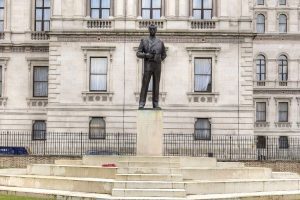
The Queen’s name of Windsor has a less than straightforward history. Invented by the pressures of war the Windsor name survives but very nearly did not.
In one of the most prominent positions in Royal London facing Horse Guards’ Parade stands an imposing statue of Louis Mountbatten. Cousin to the Queen’s father and uncle to Prince Philip, Mountbatten played a central role in the royal family’s history. While he may not have instigated the romance between the young princess and prince ,he played a central role in ensure Philip gained his British citizenship in 1947, a vital step in enabling their marriage later that year.
Philip, partly to thank his uncle adopted the Mountbatten name, leading Louis to openly brag that the ruling house would be no longer Windsor but that of Mountbatten. Mountbatten’s views were reported back to a horrified Queen Mary (the grandmother to Queen Elizabeth), whose husband King George V had founded the House of Windsor. Pressure was applied and in one of the first official announcements of her reign in 1952, the new queen declared “my descendants who marry and their descendants, shall bear the name of Windsor”. Mountbatten’s ambition that the royal house would bear his family name had been thwarted.
The house of Windsor came into being only in 1917, replacing the historical name of Saxe-Coburg-Gotha. In World War 1 anti-German feeling was strong and the bombing of a London school leading to the death of 18 children by a Gotha bomber plane was the last straw for the Saxe-Coburg-Gotha name. At the same time the British sounding Mountbatten name was invented, Louis’ father being formerly Prince Louis of Battenberg.
My new tour for the Jubilee, the Royal London Coronation tour explores some of the fascinating history behind the young Queen and her coronation in 1953.
Learn more and book the Royal London Tour.



